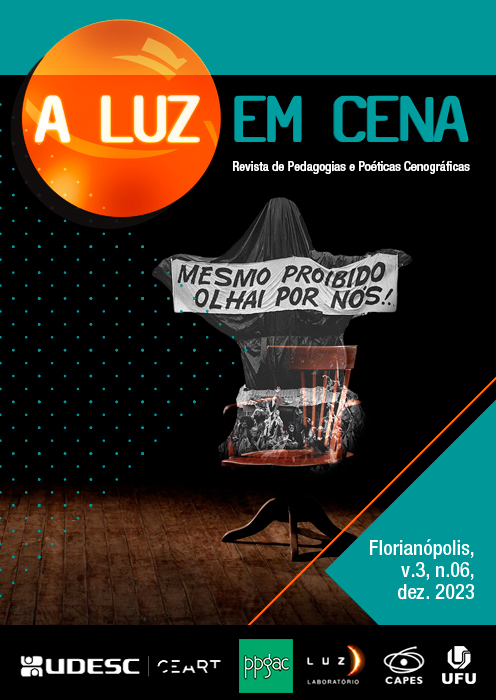The ephemeral and intriguing scenography, between wires, poles and walkways, follows the streets for the procession
DOI:
https://doi.org/10.5965/27644669030620230203Keywords:
samba school, scenography, float, allegories and props, plotsAbstract
This article addresses the use of scenography techniques in the context of Samba School parades, with a special focus on floats. Furthermore, it explores some landmarks, in a speculative way, in the probable origins of itinerant scenography, exemplified by allegories and props, based on cultural influences that date back to theatrical groups such as Ancient Greece. As Simões (2008) adds, this rural festivity is brought from the fields to cities around 539 BC (by Thespis) and it is from this time on that the Greek State took over the organization of theater, establishing competitions among dramatic poets. Thus, the actor Thespis with his cart is considered by many to be the embryo for the development of theater and itinerant scenography, he was essential. The Greek actor from Attica had a new and creative idea that would make history along the paths he took. When traveling around Greece with his decorated cart, Car of Thespis, he appeared as part of the choir as a soloist, causing the cart decorated with leaves and grapes, composed with the human choir, to form the scene, therefore, here, speculation on the bases for itinerant scenography based on fact. The study also highlights the importance of itinerant scenography, with a locus at the beginning of the 13th century, when Pope Urban IV instituted the festival marked by processions. We assume, due to the processional character, that it contributed to the foundations of the Samba School parades. In this medieval context, known as the “dark period” of theater, itinerant scenography played a vital role in preserving theater as we know it today. As a response to the Roman attempt to suppress Greek theater, another milestone was the emergence of artists who wore costumes and makeup, presenting everyday situations. Popular groups were organized for these performances, involving clowns, buffoons, comedians and animal tamers performing on improvised stages mounted on carts that moved from one square to another. Nowadays, in Rio de Janeiro, the tradition of itinerant scenography is still alive, with parades of floats in the city streets during Carnival. It is important to highlight that the emergence of Samba Schools was a marginal response from the less well-off social classes, black people and poor immigrants, who sought social acceptance through their parades during Carnival in the city of Rio. These schools gave a new dimension to Carnival parades, creating a legacy that persists today. With the floats as great scenography that parade in procession and arouse great fascination in one of the greatest open-air spectacles on earth. It should be highlighted here that this is our abstract vision with a view to the itinerant scenography of the Samba Schools, and it should be emphasized that other forms of scenographic presentation are important for the journey, such as the Brazilian Circus and the Large and Small Carnival societies. The rigorous evaluation of the scenography by the judges, following criteria from the Independent League of Samba Schools (LIESA), highlights the importance of scenography as an element of competition and high artistic quality in the parades. In short, for us on the abstract path outlined here, scenography in the Samba Schools of Rio de Janeiro is an artistic manifestation deeply rooted in popular culture and based on the history of theater. Its continuation as an ephemeral and impactful art form is a vital part of Rio Carnival.
Downloads
References
ABEL, Lionel. Metateatro. Rio de Janeiro: Zahar Editores,1968.
AMARAL, Marly Spinola do (2012). Tijuca!!! não é segredo eu amar você! 1.ª ed. Rio de Janeiro: Marly Spinola do Amaral. ISBN 978-85-913233-0-2.
ARAÚJO, Eugênio. OS TEMAS-ENREDOS DAS PEQUENAS ESCOLAS DE SAMBA CARIOCAS. Texto escolhidos de cultura e arte populares. Rio de Janeiro, v.7, n.2, p. 149-164, nov. 2010.
ARNHEIM, Rudolf. Arte e Percepção Visual. São Paulo: Pioneira, 1995.
AUGRAS, Monique. O Brasil do samba-enredo. Rio de Janeiro: Fundação Getúlio Vargas,1998.
AUMONT, Jacques. A imagem. Campinas, SP: Papirus, 2004.
BABLET, Denis. e JACQUOT, Jean. Le Lieu Théatral dans la Société Moderne. Paris: Centre National de la Recherche Scienti que, 1988.
BACELAR, Jorge. Linguagem da Visão. www.bocc.ubi.pt. Acesso em 03 de fev. de 2003.
BASTOS, João. Acadêmicos, unidos e tantas mais - Entendendo os desfiles e como tudo começou. Rio de Janeiro: Folha Seca, (2010).
BAUHAUS. Archiv/Museum für Gestaltung. https://www.bauhaus.de/de/bauhaus-archiv/. Acesso em 23 dez. de 2003.
BERTHOLD, Margot. História Mundial do Teatro. São Paulo: Perspectiva, 2001.
BORIE, Monique; ROUGEMONT, Martine de; SCHERER, Jacques. Estética Teatral. Textos de Platão à Brecht. 2oed. Lisboa: Fundação Calouste Gul- benkian, 2004.
BRANDAO, Junito. O Teatro Grego - origem e evolução. Rio de Janeiro, 1980.
BRINGHURST, Robert. Elementos do Estilo Tipográ co. São Paulo. Cosac&Naify. 2005.
BROOK, Peter. O Teatro e seu Espaço. Petrópolis: Vozes, 1970.
BURINI, Débora. Cenogra a em Telenovela: Leitura de uma Produção. Dissertação de Mestrado, São Paulo: PUC, 1996.
CALVENTE, Emerson. Cenogra a Virtual. São Paulo: Revista Telaviva, jun 2001.
CAMPOMORI, Maurício J. L. A transdisciplinaridade e o ensino de projeto de arquitetura http://www.vitruvius.com.br/arquitextos/arq000/esp234.asp. Acesso em 19 jun. de 2004.
CAMPOS, Haroldo de. Ruptura dos Gêneros na Literatura Latino-americana. São Paulo: Perspectiva, 1977.
CARDOSO, João Batista Freitas. Cenário Virtual. Uma representação tridimen- sional no espaço televisivo. Dissertação de mestrado, São Paulo: PUCSP, 2002.
CARLSON, Marvin. Teorias do Teatro. São Paulo: UNESP, 1997.
CHALHUB, Samira. Funções da Linguagem. São Paulo: Ática, 2000.
CHALHUB, Samira. A Metalinguagem. São Paulo: Ática, 2001.
COELHO NETTO, José Teixeira. Em Cena, O Sentido: Semiologia do Teatro. São Paulo: Duas Cidades, 1980.
DECUGIS, Nicole e REYMOND, Suzanne. Le Décor de Thêatre en France du Moyen Age à 1925. Paris: Compagnie Française des Arts Graphiques, 1953.
DPA - The Digital Performance Archive. http://dpa.ntu.ac.uk/dpa_site/. Acesso em 20 jul. de 2004.
DUCLÓS, Miguel. Sobre o conceito de mimesis e katharsis na Poética de Aristóteles. http://www.consciencia.org/antiga/aripoeti.shtml. Acesso em 23 mai. de 2004.
DUCROT, Oswald e TODOROV, Tzvetan. Dicionário Enciclopédico das Ciências da Linguagem. São Paulo: Ed. Perspectiva, 2001.
EISNER, Lotte. O Écran Demoníaco. Aster Lisboa. s.d.
FALGETANO, Edylita e ROSA JR. Hamilton. 50 anos de TV. in revista Tela Viva, ago. 2000.
FARINA, Modesto. Psicodinâmica das Cores em Comunicação. São Paulo: Edgard Blücher, 1982.
FILHO, Daniel. O Circo Eletrônico: fazendo TV no Brasil. São Paulo:Jorge Zahar, 2001.
FREITAS, Lima de; MORIN, Edgar e NICOLESCU, Basarab. Carta do Primeiro Congresso Mundial de Transdisciplinaridade. Convento da Arrábida: Portugal, 1994.
FUÃO, Fernando Freitas. O sentido do espaço. Em que sentido, em que sentido? in http://www.vitruvius.com.br/arquitextos/ Acesso em 02 jun. de 2004.
GARDIN, Carlos e VENDRAMINI, José Eduardo. O Lúdico e o Didático em Brecht. in designos 6. São Paulo: Livraria Cortez, 1981.
MOTTA, Gilson. O Espaço da Tragédia. Rio de Janeiro. Perspectiva: 2011.
SANTOS, Nilton. A arte do efêmero: carnavalescos e mediação cultural na cidade do Rio de Janeiro. Rio de Janeiro: Apicuri, 2009.
SILVA, Cristina da Conceição. Do batuque do Samba ao batuque do funk. Rio de Janeiro, 2018.
PAVIS, Patrice. Dicionário de Teatro. São Paulo: Perspectiva, 1999.
Downloads
Published
How to Cite
Issue
Section
License
Copyright (c) 2024 Marcus Paulo de Oliveira, Cristina da Conceição Silva

This work is licensed under a Creative Commons Attribution 4.0 International License.



